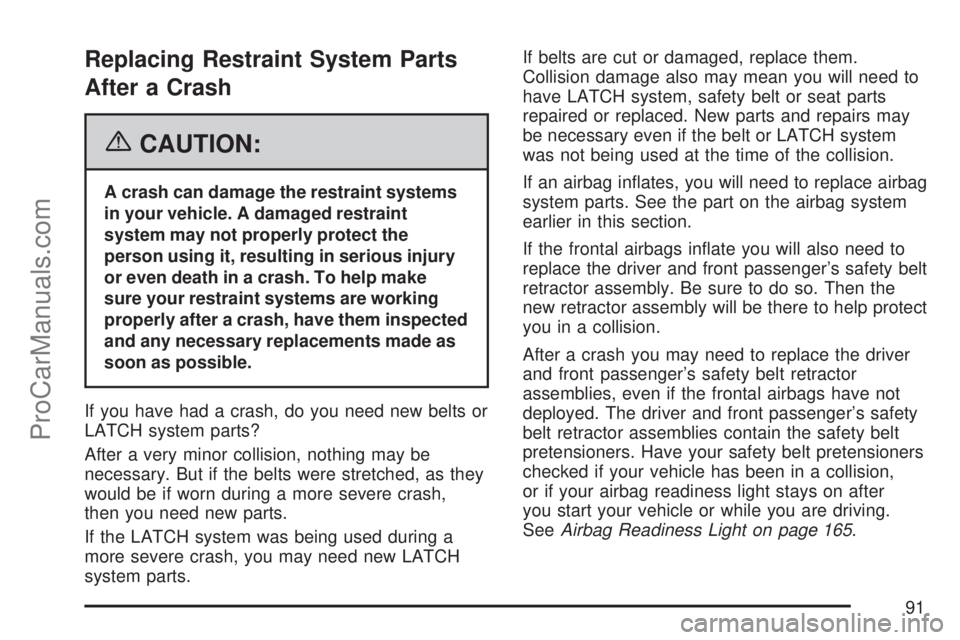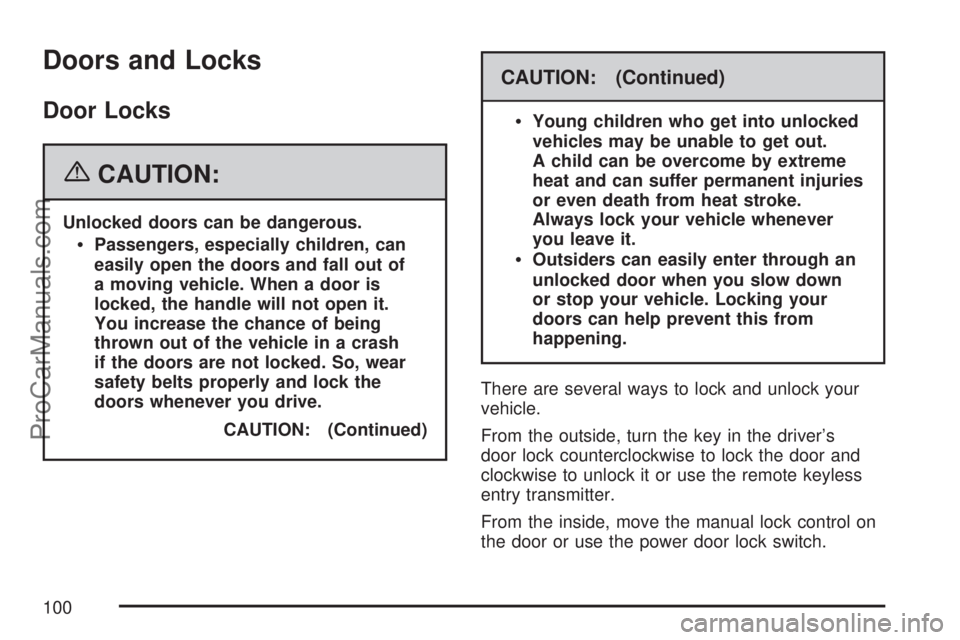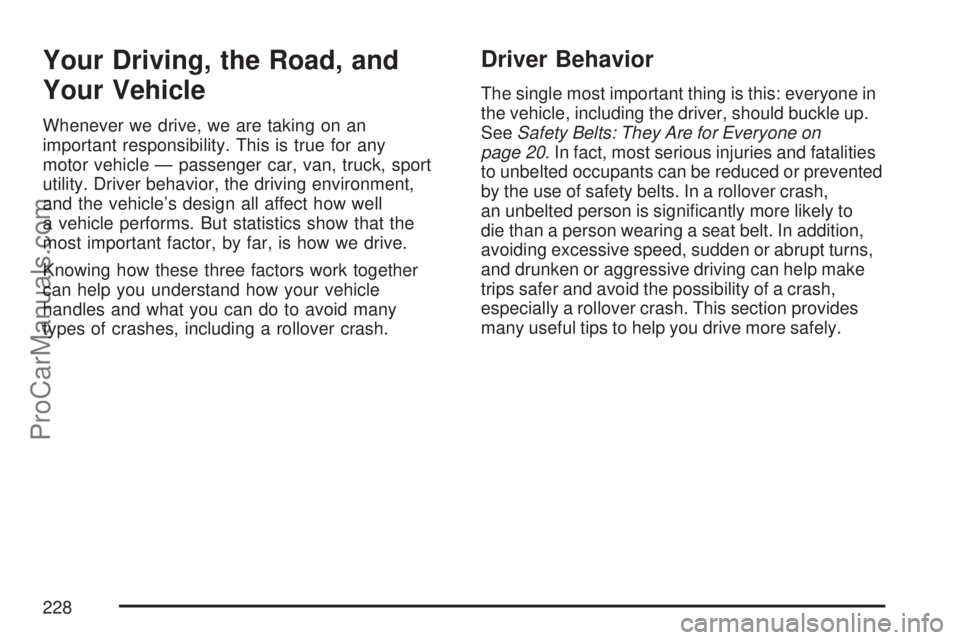belt SATURN VUE 2007 Workshop Manual
[x] Cancel search | Manufacturer: SATURN, Model Year: 2007, Model line: VUE, Model: SATURN VUE 2007Pages: 470, PDF Size: 3.1 MB
Page 80 of 470

How Does an Airbag Restrain?
In moderate to severe frontal or near frontal
collisions, even belted occupants can contact the
steering wheel or the instrument panel. In moderate
to severe side collisions, even belted occupants
can contact the inside of the vehicle. Airbags
supplement the protection provided by safety belts.
Airbags distribute the force of the impact more
evenly over the occupant’s upper body, stopping
the occupant more gradually. But the frontal airbags
would not help you in many types of collisions,
including rollovers, rear impacts, and many side
impacts, primarily because an occupant’s motion
is not toward the airbag. Roof-mounted rollover
airbags would not help you in many types of
collisions, including many frontal or near frontal
collisions, and rear impacts.
Airbags should never be regarded as anything
more than a supplement to safety belts, and
then only in moderate to severe frontal or
near-frontal collisions for the driver’s and right
front passenger’s frontal airbags, and only
in moderate to severe side collisions or rollovers
for vehicles with roof-mounted rollover airbags.
What Will You See After an Airbag
In�ates?
After the airbag in�ates, it quickly de�ates, so
quickly that some people may not even realize
the airbag in�ated. Some components of the
airbag module may be hot for a short time. These
components include the steering wheel hub for the
driver’s frontal airbag and the instrument panel for
the right front passenger’s frontal airbag. For
vehicles with roof-mounted side impact airbags,
the ceiling of your vehicle near the side windows
may be hot. The parts of the airbag that come into
contact with you may be warm, but not too hot to
touch. There may be some smoke and dust coming
from the vents in the de�ated airbags. Airbag
in�ation does not prevent the driver from seeing or
being able to steer the vehicle, nor does it prevent
people from leaving the vehicle.
80
ProCarManuals.com
Page 86 of 470

For some children who have outgrown child
restraints and for very small adults, the passenger
sensing system may or may not turn off the right
front passenger’s frontal airbag, depending upon
the person’s seating posture and body build.
Everyone in your vehicle who has outgrown
child restraints should wear a safety belt
properly — whether or not there is an airbag
for that person.
If a person of adult-size is sitting in the right front
passenger’s seat, but the off indicator is lit, it
could be because that person is not sitting properly
in the seat. If this happens, turn the vehicle off
and ask the person to place the seatback in
the fully upright position, then sit upright in the
seat, centered on the seat cushion, with the
person’s legs comfortably extended. Restart the
vehicle and have the person remain in this position
for about two minutes. This will allow the system
to detect that person and then enable the
passenger’s airbag.
86
ProCarManuals.com
Page 89 of 470

Adding Equipment to Your
Airbag-Equipped Vehicle
Q:Is there anything I might add to the front
or sides of the vehicle that could keep the
airbags from working properly?
A:Yes. If you add things that change your
vehicle’s frame, bumper system, height, front
end or side sheet metal, they may keep the
airbag system from working properly. Also,
the airbag system may not work properly if you
relocate any of the airbag sensors. If you have
any questions about this, you should contact
Customer Assistance before you modify your
vehicle. The phone numbers and addresses
for Customer Assistance are in Step Two of
the Customer Satisfaction Procedure in this
manual. SeeCustomer Satisfaction Procedure
on page 440.
Q:Because I have a disability, I have to get
my vehicle modi�ed. How can I �nd out
whether this will affect my airbag system?
A:Changing or moving any parts of the
front seats, safety belts, the airbag sensing
and diagnostic module, steering wheel,
instrument panel, ceiling headliner, ceiling
and pillar garnish trim, roof-mounted airbag
modules, or airbag wiring can affect the
operation of the airbag system. If you have
questions, call Customer Assistance. The
phone numbers and addresses for Customer
Assistance are in Step Two of the Customer
Satisfaction Procedure in this manual.
SeeCustomer Satisfaction Procedure on
page 440.
89
ProCarManuals.com
Page 90 of 470

Restraint System Check
Checking the Restraint Systems
Now and then, make sure the safety belt reminder
light and all your belts, buckles, latch plates,
retractors and anchorages are working properly.
Look for any other loose or damaged safety
belt system parts. If you see anything that might
keep a safety belt system from doing its job, have
it repaired. SeeCare of Safety Belts on page 402
for more information.
Torn or frayed safety belts may not protect you in
a crash. They can rip apart under impact forces.
If a belt is torn or frayed, get a new one right away.Also look for any opened or broken airbag covers,
and have them repaired or replaced. The airbag
system does not need regular maintenance.
Notice:If you damage the covering for the
driver’s or the right front passenger’s airbag,
or the side impact airbag covering (if equipped)
on the ceiling near the side windows, the airbag
may not work properly. You may have to replace
the airbag module in the steering wheel, both
the airbag module and the instrument panel for
the right front passenger’s airbag, or side
impact airbag module and ceiling covering for
roof-mounted side impact airbags (if equipped.)
Do not open or break the airbag coverings.
90
ProCarManuals.com
Page 91 of 470

Replacing Restraint System Parts
After a Crash
{CAUTION:
A crash can damage the restraint systems
in your vehicle. A damaged restraint
system may not properly protect the
person using it, resulting in serious injury
or even death in a crash. To help make
sure your restraint systems are working
properly after a crash, have them inspected
and any necessary replacements made as
soon as possible.
If you have had a crash, do you need new belts or
LATCH system parts?
After a very minor collision, nothing may be
necessary. But if the belts were stretched, as they
would be if worn during a more severe crash,
then you need new parts.
If the LATCH system was being used during a
more severe crash, you may need new LATCH
system parts.If belts are cut or damaged, replace them.
Collision damage also may mean you will need to
have LATCH system, safety belt or seat parts
repaired or replaced. New parts and repairs may
be necessary even if the belt or LATCH system
was not being used at the time of the collision.
If an airbag in�ates, you will need to replace airbag
system parts. See the part on the airbag system
earlier in this section.
If the frontal airbags in�ate you will also need to
replace the driver and front passenger’s safety belt
retractor assembly. Be sure to do so. Then the
new retractor assembly will be there to help protect
you in a collision.
After a crash you may need to replace the driver
and front passenger’s safety belt retractor
assemblies, even if the frontal airbags have not
deployed. The driver and front passenger’s safety
belt retractor assemblies contain the safety belt
pretensioners. Have your safety belt pretensioners
checked if your vehicle has been in a collision,
or if your airbag readiness light stays on after
you start your vehicle or while you are driving.
SeeAirbag Readiness Light on page 165.
91
ProCarManuals.com
Page 100 of 470

Doors and Locks
Door Locks
{CAUTION:
Unlocked doors can be dangerous.
Passengers, especially children, can
easily open the doors and fall out of
a moving vehicle. When a door is
locked, the handle will not open it.
You increase the chance of being
thrown out of the vehicle in a crash
if the doors are not locked. So, wear
safety belts properly and lock the
doors whenever you drive.
CAUTION: (Continued)
CAUTION: (Continued)
Young children who get into unlocked
vehicles may be unable to get out.
A child can be overcome by extreme
heat and can suffer permanent injuries
or even death from heat stroke.
Always lock your vehicle whenever
you leave it.
Outsiders can easily enter through an
unlocked door when you slow down
or stop your vehicle. Locking your
doors can help prevent this from
happening.
There are several ways to lock and unlock your
vehicle.
From the outside, turn the key in the driver’s
door lock counterclockwise to lock the door and
clockwise to unlock it or use the remote keyless
entry transmitter.
From the inside, move the manual lock control on
the door or use the power door lock switch.
100
ProCarManuals.com
Page 137 of 470

Instrument Panel Overview........................ 140
Hazard Warning Flashers.......................... 142
Horn.......................................................... 142
Tilt Wheel.................................................. 142
Turn Signal/Multifunction Lever.................. 143
Turn and Lane-Change Signals................. 143
Headlamp High/Low-Beam Changer.......... 144
Flash-to-Pass............................................ 144
Windshield Wipers..................................... 144
Windshield Washer.................................... 145
Rear Window Wiper/Washer...................... 146
Cruise Control........................................... 146
Headlamps................................................ 149
Daytime Running Lamps (DRL)................. 150
Automatic Headlamp System..................... 151
Fog Lamps................................................ 152
Interior Lamps........................................... 152
Instrument Panel Brightness...................... 152
Dome Lamp.............................................. 153
Entry Lighting............................................ 153
Map Lamps............................................... 153
Footwell Lamps......................................... 153
Battery Run-Down Protection..................... 154
Accessory Power Outlet(s)........................ 154
Cigarette Lighter........................................ 155Climate Controls......................................... 155
Climate Control System............................. 155
Outlet Adjustment...................................... 159
Passenger Compartment Air Filter............. 159
Warning Lights, Gages, and Indicators..... 161
Instrument Panel Cluster........................... 162
Speedometer and Odometer...................... 163
Trip Odometer........................................... 163
Tachometer............................................... 164
Safety Belt Reminder Light........................ 164
Passenger Safety Belt Reminder Light....... 165
Airbag Readiness Light............................. 165
Passenger Airbag Status Indicator............. 166
Battery Warning Light................................ 169
Up-Shift Light............................................ 169
Brake System Warning Light..................... 170
Anti-Lock Brake System Warning Light...... 171
Traction Control System (TCS)
Warning Light........................................ 172
Low Traction Light..................................... 173
Engine Coolant Temperature
Warning Light........................................ 173
Engine Coolant Temperature Gage............ 174
Low Coolant Warning Light....................... 174
Section 3 Instrument Panel
137
ProCarManuals.com
Page 164 of 470

Tachometer
The tachometer displays the engine speed in
revolutions per minute (rpm).
Notice:If you operate the engine above
6,900 rpm, your vehicle could be damaged,
and the damages would not be covered by your
warranty. Do not operate the engine with the
tachometer above 6,900 rpm.Notice:For the VUE Redline, if you operate
the engine with the tachometer in the shaded
warning area, your vehicle could be damaged,
and the damages would not be covered by
your warranty. Do not operate the engine with
the tachometer in the shaded warning area.
Safety Belt Reminder Light
When the key is turned to RUN or START, a
chime will come on for several seconds to remind
people to fasten their safety belts, unless the
driver’s safety belt is already buckled.
The safety belt light will
also come on and stay
on for several seconds,
then it will �ash for
several more.
This chime and light will be repeated if the driver
remains unbuckled and the vehicle is in motion.
If the driver’s belt is already buckled, neither
the chime nor the light will come on.
164
ProCarManuals.com
Page 165 of 470

Passenger Safety Belt
Reminder Light
Several seconds after the key is turned to RUN or
START, a chime will sound for several seconds to
remind the front passenger to buckle their safety
belt. This would only occur if the passenger airbag
is enabled. SeePassenger Sensing System on
page 82for more information. The passenger
safety belt light will also come on and stay on for
several seconds, then it will �ash for several more.
This chime and light
will be repeated if the
passenger remains
unbuckled and
the vehicle is in motion.
If the passenger’s safety belt is buckled, neither
the chime nor the light will come on.
Airbag Readiness Light
There is an airbag readiness light on the
instrument panel cluster, which shows the
airbag symbol. The system checks the airbag’s
electrical system for malfunctions. The light
tells you if there is an electrical problem.
The system check includes the airbag sensor,
the airbag modules, the wiring and the crash
sensing and diagnostic module. For more
information on the airbag system, seeAirbag
System on page 71.
This light will come on
when you start your
vehicle, and it will �ash
for a few seconds.
Then the light should go
out. This means the
system is ready.
165
ProCarManuals.com
Page 228 of 470

Your Driving, the Road, and
Your Vehicle
Whenever we drive, we are taking on an
important responsibility. This is true for any
motor vehicle — passenger car, van, truck, sport
utility. Driver behavior, the driving environment,
and the vehicle’s design all affect how well
a vehicle performs. But statistics show that the
most important factor, by far, is how we drive.
Knowing how these three factors work together
can help you understand how your vehicle
handles and what you can do to avoid many
types of crashes, including a rollover crash.
Driver Behavior
The single most important thing is this: everyone in
the vehicle, including the driver, should buckle up.
SeeSafety Belts: They Are for Everyone on
page 20. In fact, most serious injuries and fatalities
to unbelted occupants can be reduced or prevented
by the use of safety belts. In a rollover crash,
an unbelted person is signi�cantly more likely to
die than a person wearing a seat belt. In addition,
avoiding excessive speed, sudden or abrupt turns,
and drunken or aggressive driving can help make
trips safer and avoid the possibility of a crash,
especially a rollover crash. This section provides
many useful tips to help you drive more safely.
228
ProCarManuals.com